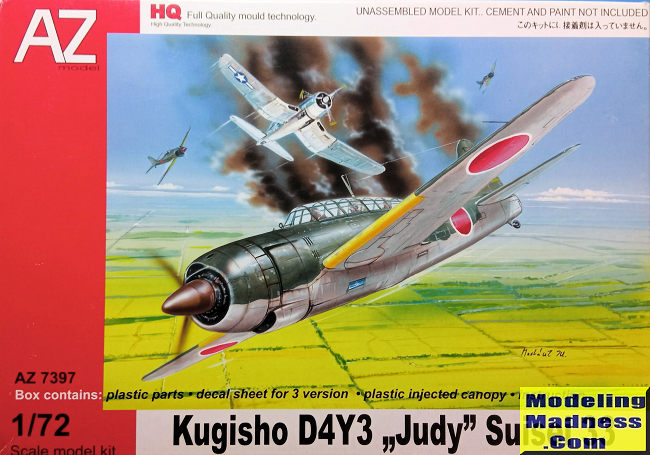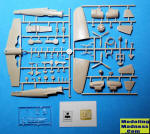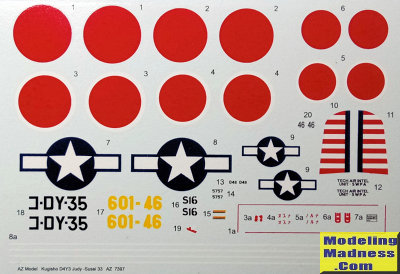
AZ Model 1/72 D4Y3 Suisei
| KIT #: | 7397 |
| PRICE: | $15.00 |
| DECALS: | Three options |
| REVIEWER: | Spiros Pendedekas |
| NOTES: |

| HISTORY |
The Yokosuka D4Y Suisei (彗星, "Comet", Allied reporting name "Judy") was a two-seat carrier-based dive bomber operated by the Imperial Japanese Navy from 1942 to 1945.The early D4Y1 and D4Y2 featured the liquid-cooled Aichi Atsuta engine, a licensed version of the German Daimler-Benz DB 601, while the later D4Y3 and D4Y4 featured the Mitsubishi MK8P Kinsei radial engine.
The type was one of the fastest dive
bombers of the war, particularly the D4Y4. It was only due to delays in its
development that its service was hindered, with its predecessor, the slower
fixed-gear Aichi D3A, remaining in service much longer than intended. The plane
was also used in other roles including reconnaissance, night fighter and special
attack (kamikaze). Like many other Japanese aircraft of the time, it lacked
armor and self-sealing fuel tanks and it was not until the final variant, the
D4Y4, that the aircraft was given bulletproof glass and armor protection for the
crew and fuel tanks. In total, 2,038 Suiseis were built.
Famously, a D4Y was used in one of the final kamikaze attacks in 1945, hours
after the surrender of Japan, with Vice Admiral Matome Ugaki in the rear
cockpit.
| THE KIT |
 Apart
from AZ, the Judy has also been served in 1/72 from as far as 1964 with the LS
offering (later reboxed by ARII) then by Fujimi in 1983 (frequently reissuing it
ever since) and by F-Toys in 2017 (with their seemingly good kit which features
pre-painted parts).
Apart
from AZ, the Judy has also been served in 1/72 from as far as 1964 with the LS
offering (later reboxed by ARII) then by Fujimi in 1983 (frequently reissuing it
ever since) and by F-Toys in 2017 (with their seemingly good kit which features
pre-painted parts).
AZ
1/72 Judys themselves appeared in 2012 in four versions (Y1, Y2, Y2S and Y3),
followed by the Y5 and other sub variants from 2019 onwards. The specific kit is
the initial edition of the radial engined D4Y3, kindly sent to me by my Polish
friend Bernard Sobzyk. The kit comes in a side opening box, featuring a very
nice box art by artist Zdeněk Macháček, depicting a Judy involved in a dogfight
scenery with a Corsair and two Zeros.
Upon opening the box,
I was greeted with 64 beige styrene parts, arranged in two equally sized sprues
(actually, it is one big sprue cut in two). A small PE fret is included, as
well. Molding is excellent with no visible flash whatsoever. Panel lines are
nicely recessed and I liked the fabric representation a lot, however I noticed
that a number of sprue gates penetrate to the parts' mating surfaces: nothing
too serious, easily shaved off with a hobby knife.
Cockpit is beautifully
done for the scale, including all basic stuff expected to be found there. The
sidewall details and structure are very well rendered, too. The instruments are
printed in acetate film that has to be sandwiched between the PE plates and the
styrene instrument panel base. Seat belts are provided in PE, as well. The
engine is also nicely done, as is the landing gear, including the busy looking
wheel bays.
Transparencies are equally well done, finely molded and crystal clear with well
defined framing. Speaking of the latter, it is quite extensive, so obtaining a
set of aftermarket masks might probably be a good idea. Instructions are good,
coming to the form of a six-page A5 b/w booklet, containing a short history of
the type, a sprue map, with the construction spread in 20 clear and
uncomplicated steps, with color callouts are given throughout in generic names
(also in Humbrol codes but only for the final camo schemes).
 Three very
interesting schemes are provided. First is an 601 Kokutai machine in the classic
IJN green over gray, as discovered by Allied troops in the Philippines.The next
is a D4Y3-5 prototype in orange color, while the third option is a captured
machine in natural metal with olive drab front anti glare section, carrying US
markings.These three schemes are printed in color at the back side of the kit
box. Decals are well registered and thin, expected to work well.
Three very
interesting schemes are provided. First is an 601 Kokutai machine in the classic
IJN green over gray, as discovered by Allied troops in the Philippines.The next
is a D4Y3-5 prototype in orange color, while the third option is a captured
machine in natural metal with olive drab front anti glare section, carrying US
markings.These three schemes are printed in color at the back side of the kit
box. Decals are well registered and thin, expected to work well.
Instructions want you
to first assemble the cockpit and trap it between the fuselage halves, then
assemble the wing and affix it under the fuselage. The tail planes are next
attached, followed by the complete assembly and installation of the engine and
its cowling, including the prop. Landing gear comes next, followed by the rear
gun, the canopy and some final tiny bits, ending a seemingly straightforward
build.
As a note, the sprues
are common to all kit editions, including all types of engines, props, exhausts,
fins, guns, windscreens and so on. Since all different version options are
described in the instructions, you can practically build every Judy version from
this boxing, provided that you can source suitable decals.
| CONCLUSIONS |
This looks to be a superb kit of this
important IJN dive bomber. Shapes of parts look correct, molding is great, panel
lines are finely recessed with convincing fabric representation, cockpit is
highly detailed as are all other key areas (engine, landing gear and so on),
clear parts are very well done and decals are wel registered and thin.
The comprehensive
instructions and the relatively uncomplicated build deem this kit suitable even
for less experienced modelers, but not for beginners (the latter might find it
somewhat challenging cleaning the parts at the sprue gates areas and dealing
with PE).
Definitely a kit worth
tackling.
Happy Modeling!
August 2023
Copyright ModelingMadness.com. All rights reserved. No reproduction in
part or in whole without express permission. If you would like your product reviewed fairly and fairly quickly, please
contact the editor
or see other details in the
Note to
Contributors. Back to the Main Page
Back to the Review
Index Page
Back to the Previews Index Page